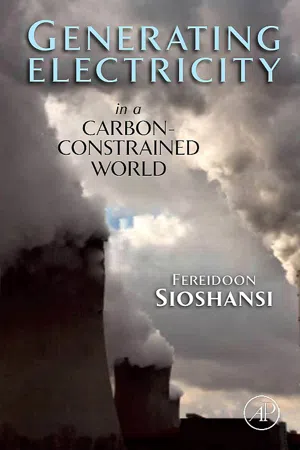
- 632 pages
- English
- ePUB (mobile friendly)
- Available on iOS & Android
Generating Electricity in a Carbon-Constrained World
About This Book
The electric power sector is what keeps modern economies going, and historically, fossil fuels provided the bulk of the energy need to generate electricity, with coal a dominant player in many parts of the world. Now with growing concerns about global climate change, this historical dependence on fossil-fuels, especially those rich in carbon, are being questioned. Examining the implications of the industry's future in a carbon-constrained world, a distinct reality, is the subject of this book.
Containing contributions from renowned scholars and academics from around the world, this book explores the various energy production options available to power companies in a carbon-constrained world. The three part treatment starts with a clear and rigorous exposition of the short term options including Clean Coal and Carbon Capture and Sequestration Technology, Coal, and Emission trading. Renewable energy options such as Nuclear Energy, Wind power, Solar power, Hydro-electric, and Geothermal energy are clearly explained along with their trade-offs and uncertainties inherent in evaluating and choosing different energy options and provides a framework for assessing policy solutions.
This is followed by self-contained chapters of case-studies from all over the world. Other topics discussed in the book are Creating markets for tradable permits in the emerging carbon era, Global Action on Climate Change, The Impossibility of Staunching World CO2 Emissions and Energy efficiency.
- Clearly explains short term and long term options
- Contributions from renowned scholars and academics from around the world
- Case-studies from all over the world
Frequently asked questions
Information
A Bridge Too Far?
Alan Moran
1.1. Introduction
Table of contents
- Cover Image
- Table of Contents
- Copyright
- Dedication
- Foreword
- Preface-Reducing the Carbon Footprint: A Multidimensional Problem
- About the Contributors
- Introduction-Carbon Constrained: The Future of Electricity Generation
- Chapter 1. Stabilizing World CO2 Emissions
- Chapter 2. Carbon Policies
- Chapter 3. Emerging Carbon Markets and Fundamentals of Tradable Permits
- Chapter 4. Making It Personal
- Chapter 5. Addressing Climate Change
- Chapter 6. Eliminating CO2 Emissions from Coal-Fired Power Plants
- Chapter 7. The Role of Nuclear Power in Climate Change Mitigation
- Chapter 8. Barriers and Policy Solutions to Energy Efficiency as a Carbon Emissions Reduction Strategy
- Chapter 9. Wind Power
- Chapter 10. Solar Energy
- Chapter 11. Geothermal Power
- Chapter 12. Hydroelectricity
- Chapter 13. Ontario
- Chapter 14. Kicking the Fossil-Fuel Habit
- Chapter 15. Carrots and Sticks
- Chapter 16. CO2 Regulations
- Chapter 17. Low-Carbon Electricity Development in China
- Chapter 18. California Dreaming
- Chapter 19. RTOs, Regional Electricity Markets, and Climate Policy
- Epilogue. Two Surprises and One Insight
- Index